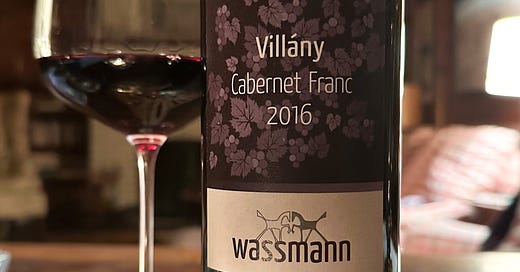Since I started this project, perhaps one of the most surprising places where Cabernet Franc appears as a star varietal in single varietal wines is Hungary. When we think of Hungarian wine, generally Tokaj is the first thing to come to mind, with Bikavér (or Bull’s Blood), a Kékfrankos-based red blend, being the country’s second most well-known wine style. But as the country’s fifth most planted variety with about 1450 hectares (about 3600 acres) under vine, Cabernet Franc is emerging as an important second red grape (after Kékfrankos) that many producers are choosing to elevate as a signature wine in their ranges.
Cabernet Franc is planted in every single region in the country (even Tokaj!), and the leading regions for the variety are Villány in the south with about 340 hectares, followed by Eger and Skekszárd (the two regions authorized to produce Bikavér) with 253 hectares and 235 hectares, respectively. But it is Villány that is really banking on Cabernet Franc to be their star variety, where it is currently the second* most planted variety overall with about 15% of the area under vine in the region, and the region even has an official PDO (protected designation of origin) for 100% Cabernet Franc from Villány called Villányi Franc, which has specific yield and aging requirements.
Located in Southern Hungary, about 10km north of the border of Croatia, Villány has a continental climate with Mediterranean influences and the most sunshine hours of any region in Hungary, making it the leading region for red wine production in Hungary. And Cabernet Franc has a long history here thanks to the work of scientist and rootstock breeder Zsgimond Teleki, a native of Villány and the person who introduced the grape to the region in the late 1800s post-phylloxera.
My first tasting video featuring a Cabernet Franc from Hungary showcased the Wassmann 2016 Cabernet Franc from Villány back in September 2021, and earlier this week I decided to check in on this wine to see how it was evolving.
Ralf Wassmann and Susann Hanauer started their winery in 2002 and farm 2 hectares of vineyards in the village of Siklós in Villány. They were the first producer in the region to receive organic certification, and they have been certified biodynamic with Demeter since 2011. They’re farming 0.7 hectares of Cabernet Franc, from which they make a single varietal red wine, as well as a pet-nat made in a blanc de noir style, and also a Kékfrankos-Cabernet Franc blend. Their Cabernet Franc was planted in 2007 in a cooler part of Villány, at an elevation of about 225m above sea level, on deeper clay-limestone soils. In the cellar, they take a low interventionist approach and eschew the use of new oak.
What struck me immediately about this wine was how youthful it presented in the glass. With 8 years of age, I would’ve surely expected some tertiary notes to start peaking through, but the wine overall still shows beautiful freshness and vibrancy. The sweeter, slightly riper red and dark fruits lead, with notes of red and black raspberry and cassis, and hint at the warm region origins of the wine. These fruits continue on the palate, which is plush, fleshy and open, with additional layers of marjoram, tobacco and cigar box, and a pleasant spice profile of allspice, paprika and chilli flake that provide a bit of lift towards the finish. While the acidity is still quite persistent and mouth-watering, the tannins have evolved a bit in their profile, becoming much more uniform and better integrated with the fruit and acidity over the last three years. This a complex, richly-textured Cabernet Franc with lots of life left in it. It is structured and voluminous, but with focus, energy and a lot of elegance to balance that warmer climate profile. It is also an absolute delight to drink! So scrumptious and pleasurable, particularly as the weather has turned a bit chilly here in southern Ontario.
This wine has remained one of my favourites from Villány because of its authenticity, restraint and finesse. It’s not overdone or trying too hard. It’s an honest wine, with a ton of character. And thankfully, I have one more bottle in my cellar, which I intend to tuck away for a while to see where it goes!
(*As of 2023, Cabernet Sauvignon beats Cabernet Franc in terms of plantings in Villány with about 390ha to Cab Franc’s 340ha. But I remain optimistic that one day Cabernet Franc will emerge as top grape in the region!)
From the Archives!
I’ve featured two other wines from Hungary in long format videos, one from Szekszárd and one from Eger.
Sebestyén, 2017 Porkoláb-Völgyi Cabernet Franc, Szekszárd, Pannon
Havas & Timár, 2018 "Franom" Cabernet Franc, Eger
Sourcing:
Hungarian wines aren’t as widely available outside of Hungary as many of us would like. For those living in the United States, a great source of Hungarian wine is the online retailer Taste Hungary, which is based out of Washington DC. They have a rotating selection of smaller production wines from a wide variety of regions and producers. And for my friends in Europe, they also have an online store based in Hungary that ships across the EU.





